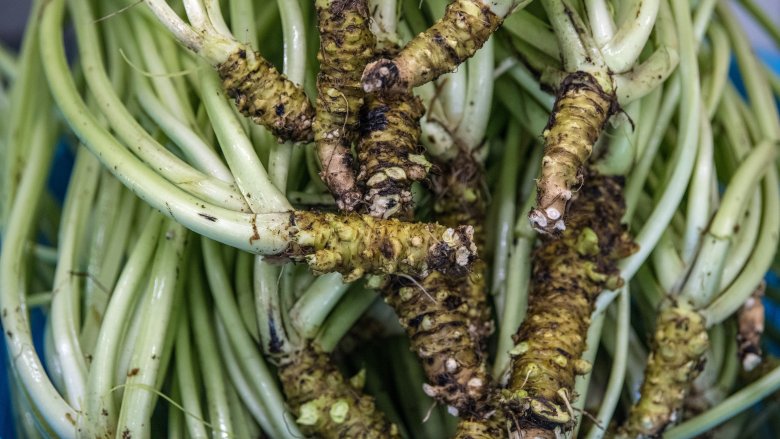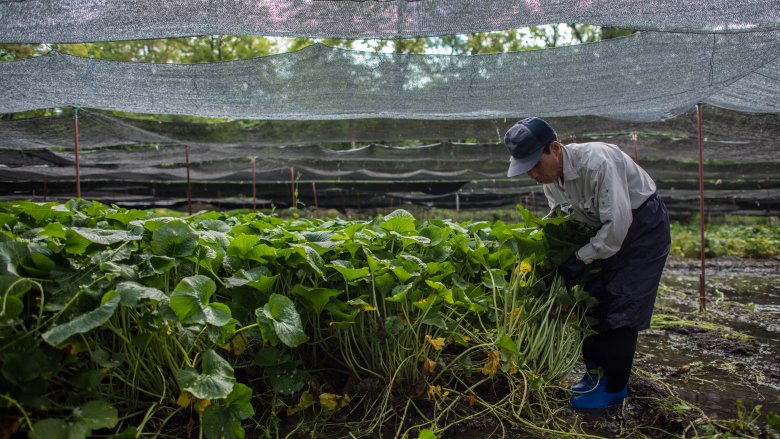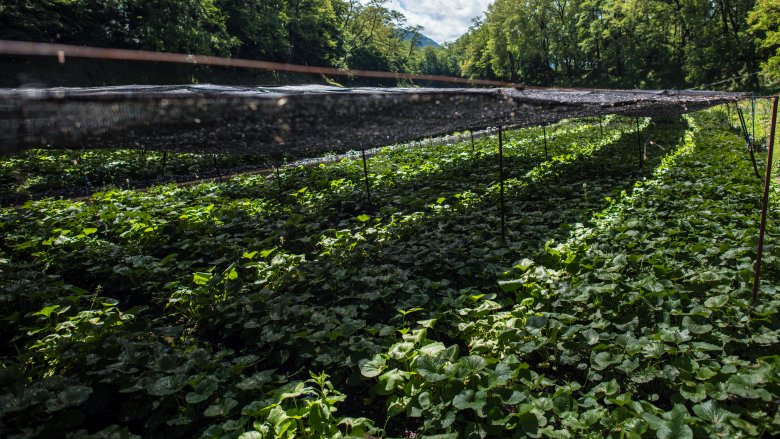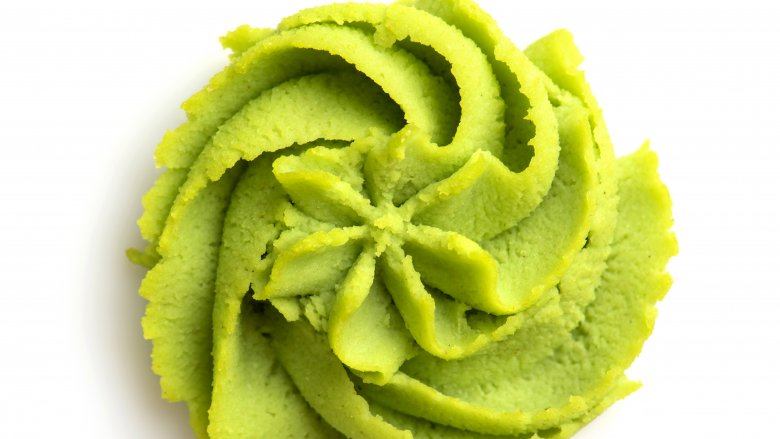What Is Real Wasabi And Why You've Probably Never Eaten It
Wasabi isn't one of those ingredients that inspire us to ask many questions. The addition of the green paste on your sushi plate is kind of a given. Even if most of us don't know what it is or where it comes from, we do know it packs a punch of flavor. Its pungent and spicy character is the perfect way to flavor a soy dipping sauce, and if you add too much it'll clear out your sinuses pretty quickly. As wasabi has become more mainstream, we've seen it used as a coating for peas in snack mixes and added to mayonnaise to fancy-up dishes like fish tacos. So, you might be surprised to learn that most wasabi you've encountered — even at fancy restaurants in Japan — isn't actually the real thing.
Real wasabi — derived from the plant Wasabia japonica — is rarer than you might think. This Japanese aquatic plant is difficult to grow, making it significantly more expensive than most condiments. According to the Washington Post, adding the real stuff to your sushi might add $3 to $5 to the bill. It's hard to imagine such a small component could be worth the price of an entire fast food meal, but you may be willing to pay for it once you've tasted pure wasabi. Read on to find out the facts about real wasabi — and what you've actually been eating, instead.
Most wasabi paste is fake
A shocking number of sushi restaurants don't serve real wasabi: The Washington Post reports that as much as 99 percent of wasabi sold in the United States is fake. It's not just the U.S., either; experts estimate that 95 percent of wasabi sold in Japan is imitation, too. So, if you're not getting the real stuff, what the heck is in your fake wasabi?
It's a pretty convincing swap, especially if you don't have anything to compare it to. The wasabi you'll find in most restaurants and grocery stores is a mixture of horseradish, mustard powder, and food coloring. The nasal-clearing properties of the horseradish and mustard come together to give you the illusion that you're eating the real deal, and the food coloring gives it a green hue. Some mixtures also include cornstarch or other chemical stabilizers to help the powder thicken up like freshly grated wasabi.
Where does wasabi come from?
Real wasabi comes from grating the root-like stem (called a rhizome) of a perennial plant native to Japan, Wasabia japonica. It looks a lot like a green-colored horseradish root, and the two share similar flavor profiles, too. That's because wasabi is a member of the same Brassica family as horseradish and mustard — the main reason why using horseradish powder as a substitution works so well.
The perennial plant originated along cold mountain streams and rocky river beds in Japan. The earliest mention of wasabi is in the Honzo Wamyo, an 18-volume medical dictionary written in 918 AD, indicating that the plant may have been used for medicinal purposes. In the 1800s during the Edo period, its modern-day use as a seasoning for sushi became popular, and the rest is history. Although it's still grown in Japan, there are several wasabi farms outside Asia, including New Zealand, North America, and the UK.
Wasabi notoriously difficult to grow
You might wonder why you've never seen a wasabi plant, considering it's been around for so long. It might have something to do with how difficult the plant is to cultivate. In fact, BBC once called it the "hardest plant to grow," and making mistakes can become very costly for wasabi farmers. The seeds themselves are almost a dollar each, and they often don't germinate. The plant is super picky about its environment, and if it's exposed to too much humidity, too little water, or the wrong nutrients, it will wither and die.
It's not impossible to grow, though, and many plants do make it past the germination stage. The next hurdle is overcoming fungal disease and stem rot, conditions common among plants grown in wet conditions. Even if everything goes well and disease is avoided, it can take as long as three years for the plant to mature. All that adds up to less wasabi supply than the world-wide demand, jacking up the price and making it unattainable for most.
Once you've had it, you can taste the difference
After hearing about how difficult the plant is to grow, you might wonder if it's even worth it. The green-dyed horseradish mixture is pungent and hits you with a nasal-clearing effect as soon as you take a bite. If you've ever had real wasabi, you know that it is spicy, but it's not that hot. It has more of a plant-like, herbaceous flavor/odor combination that the Art of Eating describes as having "fresh, green, sweet, fatty, fragrant, and picklelike" odors.
Chemical and Engineering News explains the science behind what you taste when you take a bite of wasabi (fake or real). Several enzymes are released when you grate horseradish or wasabi roots, including one known as allyl isothiocyanate (AITC) that's responsible for creating the sensation of heat. Because horseradish has more AITC, your palate perceives it as spicier. In a 2003 study, researchers went on to find that wasabi contains more volatile compounds than horseradish, giving it a more complex flavor. Instead of just being blasted by spicy flavor, real wasabi has a smoother, cleaner taste that won't overtake delicate fish as you eat it.
The leaves of the wasabi plant are also edible
Although the wasabi rhizome contains the most concentrated flavor, the entire plant is edible. The plant itself is beautiful, growing to about two feet tall with long, crisp stems that shoot above the ground. The heart-shaped leaves get as large as a small dinner plate and are common additions to salads or stir-fry dishes in Japan. The most popular use of the wasabi plant is a pickled dish popular in Shizuoka Prefecture called wasabi zuke. The recipe utilizes chopped up stems, leaves, flowers, and groundstalks that are pickled by mixing them with salt, sugar, and sake lees (a byproduct of the sake brewing process).
The wasabi plant can be eaten raw or cooked, but the components taste spicier if they're raw. Cooking them results in a spinach-like flavor. The leaves don't last as long as the rhizomes (seven days in the refrigerator versus the rhizome's two-month shelf life), so plan to cook them up quickly if you can get your hands on these prized items.
Real wasabi costs quite a bit more
The wasabi served with sushi in a restaurant is easy to pick as a fake: It's provided (usually free) on the side of every plate. It would be difficult for restaurants to use real wasabi that freely, because it's more expensive than the fake varieties. Because the plant is so hard to grow, the supply tends to be lower than the demand, driving up the cost.
According to Live Japan, a kilo of exported wasabi cost $160 in 2014 (or, about $72 a pound). They estimate the price has gone up by about 10 percent over the years, leading some restaurants to pay as much as $300 per kilo. Compare that to the wholesale cost of easy-to-grow horseradish and mustard, which is likely available for less than $5 per kilo, and you can see why many restaurants choose fake wasabi powders. While real wasabi prices don't even come close to many of the world's most expensive foods, it's still way too pricey to give away for free.
Some wasabi growers keep their farms in secret locations
It's extremely difficult to grow wasabi outside of Japan, but that hasn't stopped farmers from trying. Given how high the demand is, growers can stand to make a lot of money if they can get past the poor germination rates and the plant's high likelihood for disease. Some farmers figured it out, like Brian Oates, who became interested in wasabi as he was getting his PhD in marine botany at the University of British Columbia.
In an interview with Buckteeth Magazine, Oates admits that they don't allow visitors at their farms, which are all at secret locations. "The growing method is all a trade secret," he explains. "We do that because if we patented it we would have to tell everyone how we do it. It's the same model that the guys at Coca Cola use. Have as few people as possible know the recipe."
According to BBC, Oates eventually created a franchise-like business model for growing wasabi. For a $70,000 license fee, you can become part of the franchise and receive the secret greenhouse growing technique. Pacific Coast Wasabi Ltd. now has nine farms — four in British Columbia, four in Washington State, and one in New York — although their exact locations are still hush-hush.
Both real and fake wasabi may protect against food poisoning
Like most food pairings, there's a reason why people started eating ground wasabi with their sushi. It turns out that both wasabi and horseradish contain a compound that may prevent food poisoning. Historians believe that wasabi was originally combined with food during the Edo period because its potent aroma reduced the fishy smell of food. It became a particularly popular combination with sushi fish because they believed in its ability to stop bacteria from growing.
Today, studies have shown that's because of something called allylisothiocyanate, a compound that comes out upon grating wasabi and horseradish. It might be hard to pronounce, but its function is pretty simple: To inhibit the growth of food poisoning bacteria and fungi. The American Council on Science and Health goes on to say these compounds work as antimicrobial agents effective against bacteria such as E. coli and Staphylococcus aureus, too. That's good news, because consuming raw and undercooked seafood (like sushi) comes with certain health risks, including contracting listeria, salmonella, and tapeworms. Wasabi isn't a cure if you encounter less-than-fresh fish, but it never hurts to have a little backup on your side just in case.
But real wasabi is also good for your health
If you're wondering if wasabi is good for you, the answer is a pretty resounding yes. In addition to its antimicrobial and antibacterial properties, wasabi may also have cancer-preventing properties. That same compound that gives wasabi its spicy kick also appears to bind to cancerous cells, causing cell death. Interestingly enough, according to research, these compounds only target protein cells that are defective while leaving normal cells alone, making them quite effective. Wasabi also contains isothiocyanates which can neutralize carcinogens, inhibiting the growth of cancerous cells.
University Health News also reports a slew of other health benefits of wasabi, from lowering inflammation and improving heart health. Studies find that supplements made with wasabi might help suppress obesity, and studies on rats that use extracts from wasabi leafstalk indicate that consuming the plant can help prevent bone loss.
A microplane grater works, but a sharkskin grater is best for wasabil
If you can get your hands on a wasabi rhizome, you might be tempted to grate it like ginger, horseradish, or garlic. While you can absolutely use a microplane to grate wasabi, you won't get the full benefit of the plant's flavor and texture without a sharkskin grater. These specialty graters are affixed with a piece of textured sharkskin that is specifically designed to break down the wasabi root without producing any heat. That keeps the spicy compounds as fresh as possible, letting them showcase their nuanced flavor.
If you use a different type of grater, you can still grate the root into tiny shreds — which is certainly better than mixing fake wasabi powder with water — but it won't produce a paste. The sharkskin grater actually mashes the root, creating a thick, creamy consistency similar to mashed potatoes. It not only adds flavor to your sushi, but it also adds texture as well.
Once grated, wasabi loses its flavor quickly
Add water to powdered faux wasabi and it'll taste the same for hours. Freshly grate the real deal, and you'll only have about 15 minutes to enjoy the flavor. What's the deal? It all has to do with those volatile compounds that get released when wasabi is grated. They're responsible for delivering the spicy and plant-like flavors to your palate, but unfortunately, these compounds are also time sensitive. As soon as they're exposed to oxygen, wasabi's flavor starts to dissipate.
If you accidentally grate too much, you can add vinegar or lemon juice to stabilize the mixture, but it probably won't taste the same as the freshly grated variety. Knowing this little secret is a good way to know if you're getting real wasabi at a restaurant. Spy the chef grating wasabi every 10 to 15 minutes and you know it's real. If they pull it from a large container filled with green pulp, it's likely fake wasabi.
You can order real wasabi powder or paste online
Unfortunately, since wasabi is in short supply, it's challenging to find the real deal at your local grocery store. If you live in a large city with an ethnic market or Asian grocery store, you may be able to find the rhizomes in the produce section. The pale, green root looks a little bit like ginger, or a Brussels sprout stalk once the sprouts are removed.
Luckily, we live in a world of e-commerce, and you can order almost anything online. Look for pastes and powders that list the ingredients in English so you can verify that you're buying the real deal. If the ingredients list has anything other than wasabi or Wasabia japonica listed, move on. If you want to be 100 percent sure you're getting what you pay for, you may want to consider ordering a whole rhizome. Some companies sell them frozen, but others have freshly harvested rhizomes available. Just get ready to pay; they go for about $100 a pound.
Wasabi rhizomes are good in the refrigerator for over a month
You might be worried about wasabi's storability. After all, if the compounds are so volatile, why should you spend so much money on something that will lose its flavor quickly? Luckily, powdered wasabi has an extremely long shelf life if it's stored in a cool, shaded location. Fresh wasabi rhizomes go bad more quickly, but they'll last for two months or more in the refrigerator if they're wrapped in a damp paper towel and stored in an open plastic bag. To test their shelf-life claim, Frog Eyes Wasabi farm from the Oregon coast sampled two-month-old wasabi next to a freshly harvested rhizome. Turns out, no one could tell the difference.
If you do find yourself with an excess of wasabi root, you don't have to rush for sushi take-out to use it up. Oregon Coast Wasabi recommends serving your favorite steak with freshly grated wasabi instead of horseradish sauce for a fun twist on a classic. Or you can fold it into mashed potatoes, use it in salad dressings, or add flavor to soba noodles. There are endless ways to use wasabi as a flavor enhancer, so don't be afraid to think outside the sushi.
Are you following sushi etiquette with your wasabi use?
According to Japan Today, there is a precise code of etiquette when it comes to eating sushi, and some of them involve wasabi use. (Yes, there are rules, and you may be breaking them.) Although most Westerners mix wasabi into their soy sauce, that's not actually its purpose. It's intended to be added in small amounts directly onto the sushi before eating. The soy sauce is there for dipping, but only the non-rice parts are supposed to touch it (another rule).
These rules apply to fake wasabi, too, so you may want to think twice before mixing up a soy-wasabi dipping sauce next time you're at a restaurant. When in doubt, it's always best to try the sushi without wasabi first — the sushi chef has probably already added the proper amount to the dish. If you like your sushi spicy, add a tiny dollop directly onto the fish before taking a bite.














